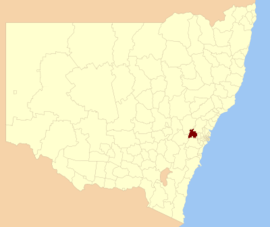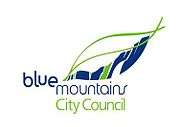City of Blue Mountains
| City of Blue Mountains New South Wales | |||||||||||||||
|---|---|---|---|---|---|---|---|---|---|---|---|---|---|---|---|
 Location in New South Wales | |||||||||||||||
| Coordinates | 33°42′S 150°18′E / 33.700°S 150.300°ECoordinates: 33°42′S 150°18′E / 33.700°S 150.300°E | ||||||||||||||
| Population | 76,904 (2016 census)[1] | ||||||||||||||
| • Density | 53.78/km2 (139.3/sq mi) | ||||||||||||||
| Established | 1 October 1947[2] | ||||||||||||||
| Area | 1,430 km2 (552.1 sq mi) | ||||||||||||||
| Mayor | Mark Greenhill (Labor) | ||||||||||||||
| Council seat | Katoomba[3] | ||||||||||||||
| Region | Blue Mountains | ||||||||||||||
| State electorate(s) | |||||||||||||||
| Federal Division(s) | Macquarie | ||||||||||||||
 | |||||||||||||||
| Website | City of Blue Mountains | ||||||||||||||
| |||||||||||||||

The City of Blue Mountains is a local government area of New South Wales, Australia, governed by the Blue Mountains City Council. The city is located in the Blue Mountains range west of Sydney.
The Mayor of Blue Mountains City Council is councillor Mark Greenhill, a member of the Labor Party.
Towns and villages in the local government area
The urban part of the city consists of a ribbon of close or contiguous towns which lie on the Main Western railway line, served by NSW TrainLink's Blue Mountains Line, and Great Western Highway between Emu Plains and Lithgow. About 70% of the city's area is within the Blue Mountains National Park which lies north and south of the ribbon of towns. The National Park is part of the much larger Greater Blue Mountains Area World Heritage Site and the city brands itself as "The City Within a World Heritage National Park". The towns and villages are generally grouped into lower, mid, and upper mountains. The economy of the upper mountains is dependent almost entirely on tourism. The road to Sydney, the Great Western Highway, is mostly dual carriageway but is relatively slow due to the urban development and hilly terrain. An electric train service integrates into Sydney Trains, Sydney's suburban rail network.
The main towns and villages in the City of Blue Mountains are:
Demographics
According to the Australian Bureau of Statistics, there:[4]
- Were 75,770 people as at 30 June 2006, the 28th largest Local Government Area in New South Wales. It was equal to 1.1% of the New South Wales population of 6,827,694
- Was a fall of 505 people over the year to 30 June 2006. It detracted 0.9% from the 58,753 increase in the population of New South Wales
- Was, in percentage terms, a decline of 0.7% in the number of people over the year to 30 June 2006. In New South Wales the population grew by 0.9%
- Was an increase in population over the 10 years to 30 June 2006 of 890 people or 1.2% (0.1% in annual average terms), the 95th highest rate of a Local Government Area in New South Wales. In New South Wales the population grew by 622,966 or 10% (1.0% in annual average terms) over the same period.
| Selected historical census data for the City of Blue Mountains local government area | ||||||
|---|---|---|---|---|---|---|
| Census year | 2001[5] | 2006[6] | 2011[7] | 2016[1] | ||
| Population | Estimated residents on census night | 73,675 | ||||
| LGA rank in terms of size within New South Wales | 28 | | ||||
| % of New South Wales population | 1.1% | |||||
| % of Australian population | ||||||
| Cultural and language diversity | ||||||
| Ancestry, top responses | English | |||||
| Australian | ||||||
| Italian | ||||||
| Chinese | ||||||
| Irish | ||||||
| Language, top responses (other than English) | Italian | |||||
| Mandarin | ||||||
| Cantonese | ||||||
| Korean | ||||||
| Greek | ||||||
| Religious affiliation | ||||||
| Religious affiliation, top responses | Catholic | |||||
| No religion | ||||||
| Anglican | ||||||
| Eastern Orthodox | ||||||
| Buddhism | ||||||
| Median weekly incomes | ||||||
| Personal income | Median weekly personal income | A$ | ||||
| % of Australian median income | ||||||
| Family income | Median weekly family income | |||||
| % of Australian median income | ||||||
| Household income | Median weekly household income | |||||
| % of Australian median income | ||||||
Council
Current composition and election method
Blue Mountains City Council is composed of twelve Councillors elected proportionally as four separate wards, each electing three Councillors. All Councillors are elected for a fixed four-year term of office. The Mayor is elected by the Councillors at the first meeting of the Council. The most recent general election was held on 10 September 2016.
| Party | Councillors | |
|---|---|---|
| Australian Labor Party | 5 | |
| Liberal Party of Australia | 4 | |
| The Greens | 2 | |
| Independents | 1 | |
| Total | 12 | |
| Ward | Councillor | Party | Notes | |
|---|---|---|---|---|
| First Ward[8] | Kevin Schreiber | Liberal | ||
| Kerry Brown | Greens | |||
| Don McGregor | Labor | |||
| Second Ward[9] | Chris van der Kley | Liberal | ||
| Romola Hollywood | Labor | |||
| Brent Hoare | Greens | |||
| Third Ward[10] | Daniel Myles | Liberal | ||
| Shae Foenander | Independent | |||
| Mick Fell | Labor | |||
| Fourth Ward[11] | Mark Greenhill | Labor | Mayor | |
| Brendan Christie | Liberal | |||
| Darryl Bowling | Labor | |||
Council services
Libraries
Blue Mountains Library operates 3 full-time branches, 3 part-time branches and a service for train commuters at Springwood and Katoomba stations 2 days a week.[12]
Leisure centres
Blue Mountains Leisure Centres operate from five locations. All five locations have pools and the Katoomba and Springwood locations have gyms and offer various fitness classes.[13]
Sister cities
The City of Blue Mountains has sister city relationships with the following cities:[14]
-
 Sanda, Hyōgo, Japan
Sanda, Hyōgo, Japan -
 Flagstaff, Arizona, US
Flagstaff, Arizona, US
See also
References
- 1 2 Australian Bureau of Statistics (27 June 2017). "Blue Mountains (C)". 2016 Census QuickStats. Retrieved 6 July 2017.

- ↑ "Council history". Blue Mountains City Council.
- ↑ "Blue Mountains City Council". Division of Local Government. Retrieved 27 November 2006.
- ↑ "Regional Population Growth, Australia, 2005–06". Australian Bureau of Statistics. 30 July 2007. Retrieved 22 June 2008.
- ↑ Australian Bureau of Statistics (9 March 2006). "Blue Mountains (C)". 2001 Census QuickStats. Retrieved 6 July 2017.
- ↑ Australian Bureau of Statistics (25 October 2007). "Blue Mountains (C)". 2006 Census QuickStats. Retrieved 6 July 2017.
- ↑ Australian Bureau of Statistics (31 October 2012). "Blue Mountains (C)". 2011 Census QuickStats. Retrieved 6 July 2017.

- ↑ "Blue Mountains Ward 1 Results". Electoral Commission of New South Wales. 17 September 2016. Retrieved 18 September 2016.
- ↑ "Blue Mountains Ward 2 Results". Electoral Commission of New South Wales. 17 September 2016. Retrieved 18 September 2016.
- ↑ "Blue Mountains Ward 3 Results". Electoral Commission of New South Wales. 17 September 2016. Retrieved 18 September 2016.
- ↑ "Blue Mountains Ward 3 Results". Electoral Commission of New South Wales. 17 September 2016. Retrieved 18 September 2016.
- ↑ "Locations, Hours & Contacts". bmcc.ent.sirsidynix.net.au. Retrieved 2016-11-29.
- ↑ Day, Clear Blue. "Blue Mountains Leisure Centres - Centres". www.bmleisurecentres.com.au. Retrieved 2016-11-29.
- ↑ "Sister Cities". Blue Mountains City Council. Retrieved 1 April 2011.